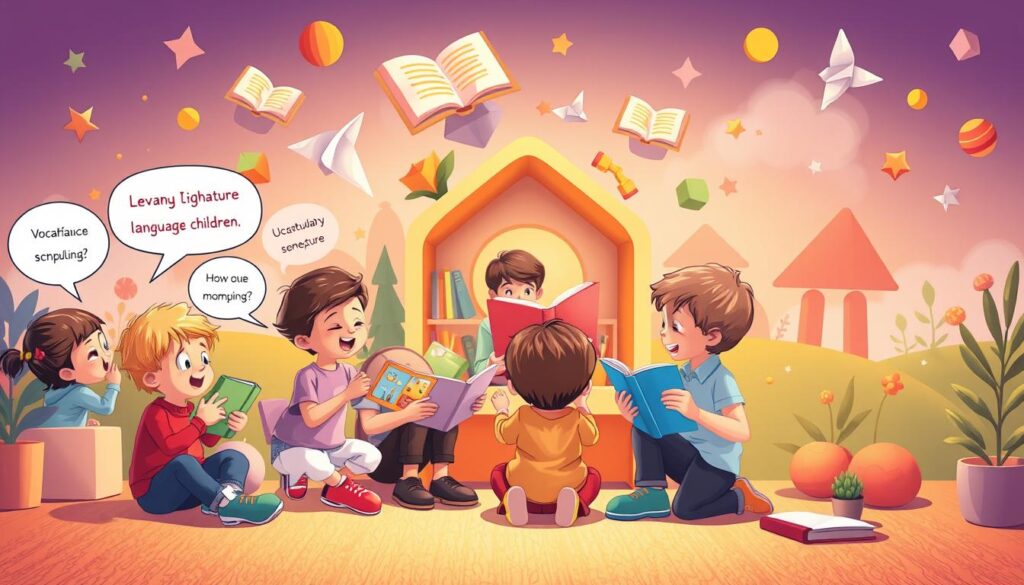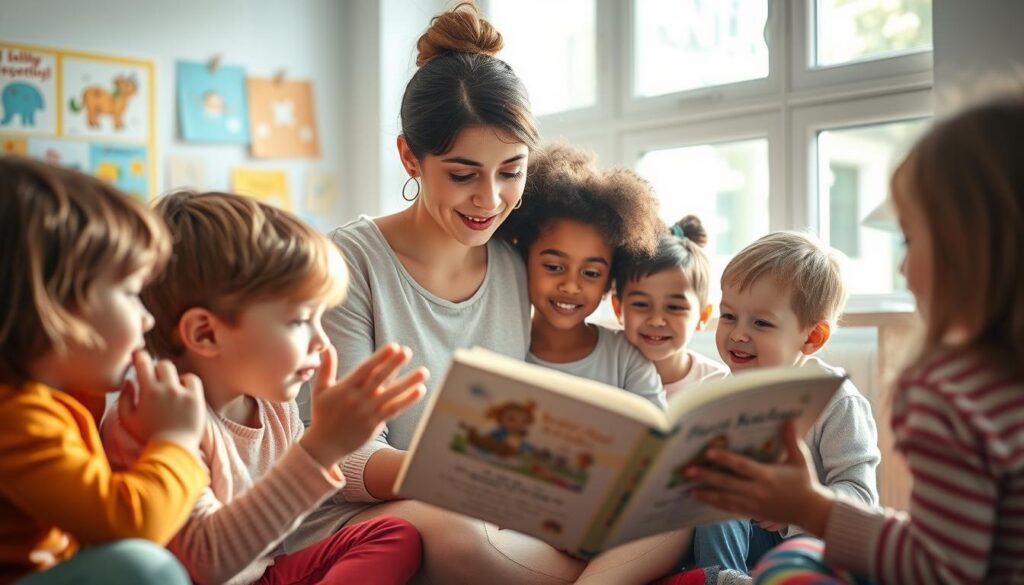Are you wondering if your child’s communication skills are on track?
The first three years of life are crucial for acquiring speech and language skills. During this period, the brain is most receptive to language absorption, making it an ideal time for exposure to various sounds, sights, and linguistic interactions.
As a mother and language specialist, I’ve seen how understanding these developmental stages can ease parental worries. By exploring the milestones and leveraging the power of storytelling, you can support your child’s language journey and help them develop essential skills.
Understanding Language Development in Young Children
The early years of a child’s life are crucial for language development, setting the stage for their ability to communicate effectively. During this period, children absorb language rules and patterns with remarkable efficiency.
The Critical Period for Language Acquisition
Research suggests that the human brain is uniquely wired for language acquisition between ages 2-5. This critical window is when children can absorb language rules and patterns with remarkable efficiency. It’s a period of significant growth, during which children begin to understand and communicate through language.
Receptive vs. Expressive Language Skills
It’s essential to distinguish between receptive language (what your child understands) and expressive language (what they can communicate). Both skills develop at different rates but are equally important. Children with difficulties in either area may benefit from consulting a speech-language pathologist.
When to Be Concerned About Delays
While every child develops at their own pace, some signs may indicate a need for professional attention. For instance, if your child has trouble understanding what others say or difficulty sharing their thoughts, they might have a language disorder. Developmental Language Disorder (DLD) is a condition that delays the mastery of language skills. If you have concerns about your child’s language development, it’s crucial to consult with your pediatrician or a speech-language pathologist.
Language Development Milestones 2-5: Stories and Progress Markers
Between the ages of 2 and 5, children make tremendous strides in language development, and being aware of these milestones can help you support their progress. During this period, your child’s vocabulary expands significantly, and they begin to form more complex sentences.
Age 2-3 Years: Building Vocabulary and Simple Sentences
At this age, your child’s vocabulary explodes from about 50 words to 300+ words, and they start forming simple 2-3 word sentences like “more milk” or “daddy go.” This marks their entry into true conversation.
Key Milestones to Watch For
- Uses 3-word sentences
- Answers simple questions
- Identifies basic body parts
- Uses pronouns like “me” and “you”
Red Flags at This Age
- Having fewer than 50 words
- Not combining words
- Showing no interest in communicating
Age 3-4 Years: Expanding Communication Skills
By this age, children typically speak in more complex 4-5 word sentences, use regular past tense verbs, and can be understood by unfamiliar adults about 75% of the time. They start asking lots of questions, especially “why” questions, and engage in back-and-forth conversations.
Key Milestones to Watch For
- Uses most speech sounds (though some may be distorted)
- Describes the use of objects
- Repeats sentences
- Engages in simple storytelling
Red Flags at This Age
- Being unintelligible to strangers
- Not using sentences of at least 3-4 words
Age 4-5 Years: Developing Complex Language
Between 4-5 years, children develop sophisticated language skills, including using complex sentences with conjunctions like “because” and “but,” understanding time concepts, and following three-step directions. They can tell coherent stories with a beginning, middle, and end, and engage in detailed conversations about past events and future plans.
Key Milestones to Watch For
- Uses complex sentences
- Understands spatial concepts like “behind” or “next to”
- Answers “why” questions
- Lists items that belong in a category
Red Flags at This Age
- Struggling to be understood by others
- Having difficulty with complex sentences

Throughout these years, it’s essential to remember that children’s comprehension typically develops ahead of their expressive abilities. They understand more words and concepts than they can say, so be patient and encouraging as they navigate their language development journey.
How Stories Boost Language Development in Preschoolers
As a parent, I’ve seen firsthand how stories can boost language development in preschoolers. Reading stories to children is not just a way to spend quality time together; it’s a powerful tool for enhancing their language skills. When we read stories to children, we’re building crucial neural pathways that connect written words, spoken language, and conceptual understanding in their developing brains.
Building Vocabulary Through Picture Books
Picture books are an excellent way to introduce children to new vocabulary. They provide exposure to rich vocabulary that might not be encountered in everyday conversation, introducing an estimated 50% more unique words than typical parent-child discussions. For example, books with simple, predictable text and clear illustrations are perfect for 2-3 year olds. Choosing the right books for your child’s age group is crucial.
Developing Narrative Skills and Comprehension
Stories help children understand narrative structure, which later translates to better writing skills and reading comprehension when they enter formal education. When children retell stories in their own words, they practice organizing thoughts sequentially, using descriptive language, and considering cause and effect—all crucial higher-order language skills. This process enhances their comprehension and narrative skills.
Interactive Storytelling Techniques for Parents
Interactive storytelling techniques like asking open-ended questions, encouraging predictions, and relating stories to your child’s experiences transform passive listening into active language learning. I’ve found that dialogic reading—where you prompt your child with questions about the story and expand on their responses—significantly boosts vocabulary acquisition and verbal expression skills.
Best Types of Books for Each Age Group
For 2-3 year olds, choose books with simple, predictable text and clear illustrations. 3-4 year olds benefit from books with more complex plots and character emotions, while 4-5 year olds are ready for longer stories with more sophisticated vocabulary. Here’s a summary of the best types of books for each age group:
| Age Group | Book Characteristics |
|---|---|
| 2-3 years | Simple, predictable text; clear illustrations |
| 3-4 years | More complex plots; character emotions |
| 4-5 years | Longer stories; sophisticated vocabulary |
By choosing the right books and engaging in interactive storytelling, you can significantly enhance your child’s language development. Reading the same stories repeatedly might seem tedious to adults, but this repetition helps children master new vocabulary, internalize language patterns, and gain confidence in their comprehension abilities.
Conclusion: Supporting Your Child’s Language Journey
Supporting your child’s language development is a rewarding journey that requires patience, understanding, and the right guidance. By understanding the general language development milestones, you can provide a valuable roadmap for supporting your child’s progress.
Creating a language-rich environment at home is crucial. Engage your child in conversations, ask questions, read stories together, and respond to their interactions. This is the single most powerful way to support your child’s communication development.
If you have concerns about your child’s language development, don’t hesitate to consult with your pediatrician or a speech-language pathologist. Early intervention can make a significant difference. Remember, every child is unique, and bilingual children may follow slightly different patterns, but they ultimately benefit from managing multiple language systems.
Nurturing your child’s language skills will have a lasting impact on their social relationships, academic success, and emotional regulation. Continue to expand conversations, introduce new vocabulary, and maintain the storytelling habit. Your investment in your child’s language development will yield long-term benefits.
FAQ
What are some common language skills my child should have between 2-3 years old?
At this age, your child is likely to say around 50 words, start combining two words together, and identify simple objects and actions. They might also start to follow simple directions and understand basic questions!
How can I help my 3-4 year old expand their communication skills?
You can encourage your child to express their thoughts and feelings by engaging in conversations, reading together, and asking open-ended questions. This will help them build their vocabulary and develop more complex sentences.
What are some signs of potential language delays in young children?
If your child is not babbling or making attempts to communicate by 12 months, not saying any words by 16 months, or not combining two words together by 24 months, it’s a good idea to consult with a speech-language pathologist.
How do stories help with my child’s language development?
Reading stories to your child exposes them to new vocabulary, sentence structures, and storytelling techniques. It also fosters a love for reading and encourages them to develop their comprehension skills.
What type of books are best for my preschooler’s age group?
For preschoolers, look for books with engaging pictures, simple and repetitive text, and stories that encourage imagination and curiosity. Board books and picture books are great options for this age group!
How can I make storytelling more interactive for my child?
Try using inflection, making sound effects, and asking questions as you read together. You can also encourage your child to point to pictures, identify objects, and predict what might happen next in the story.




